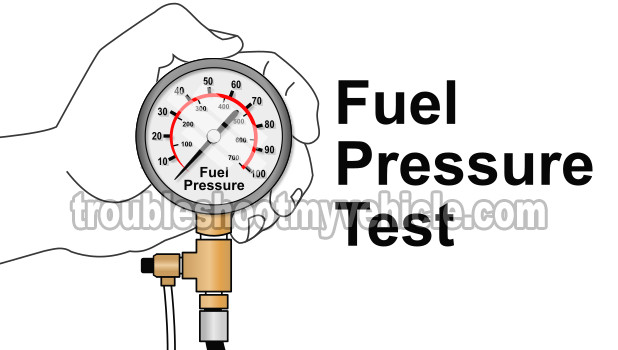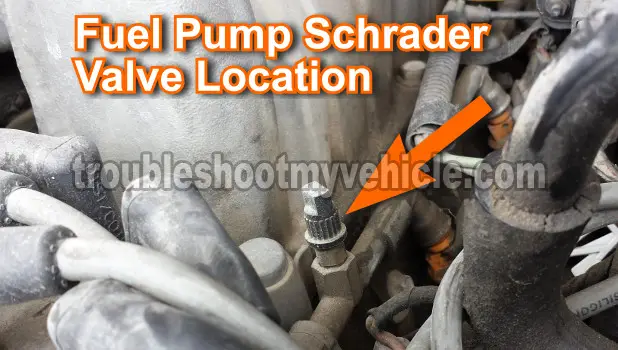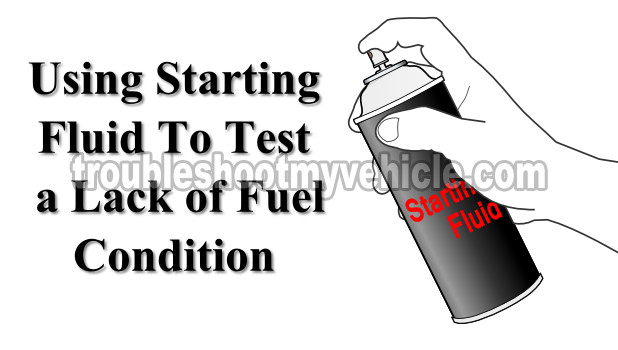
Testing to see if the fuel pump has failed (or not) on your Ford 4.9L, 5.0L, or 5.8L multi-port fuel-injected pickup/van isn't hard.
Ford was kind enough to install a Schrader valve on the fuel injector rail and it's to this valve that you and I can connect a fuel pressure test gauge to see if the fuel pump is working or not.
In this tutorial I'm gonna' explain the two methods used to check for a ‘no fuel’ condition causing a no-start condition.
One method involves using just starting fluid and the other involves using a fuel pressure gauge. One method is a very accurate way of diagnosing a lack of fuel condition causing a no-start. The other method is not that accurate.
Contents of this tutorial:
IMPORTANT: Gasoline is extremely flammable. Be careful and take all necessary safety precautions. Use extreme care when using starting fluid since it ignites as easily as gasoline. Accomplishing both tests indicated in this article, without any unhappy consequences, is more than possible if you're careful and use common sense.
Symptoms Of A Bad Fuel Pump
A bad fuel pump will make your 4.9L, 5.0L, or 5.8L multi-port fuel-injected pickup (van or SUV) crank but not start. Here are some more specific symptoms:
- The ignition system is creating and delivering spark to the spark plugs. So you know that the ignition system is not at fault (in other words: the ignition control module is OK, the ignition coil is OK, etc.).
- You've sprayed starting fluid (or carburetor spray) into the throttle body and your vehicle started, even if only momentarily.
- You don't hear the fuel pump making a buzzing sound as you turn the key to the On position or crank the engine.
- You don't see the fuel injectors spraying gasoline.
- You've checked and confirmed that the fuel pump inertia switch HAS NOT activated.
Although the above list is a not a very complete list of symptoms, the theme that runs thru' them, and any other related symptom, is that the engine will crank and crank, but not start.
IMPORTANT: You should first check the fuel pump inertia switch before starting your fuel pump diagnostic. For more info go to: Checking The Fuel Pump Inertia Switch.
Where To Buy A Fuel Pressure Gauge
The fuel pressure test gauge kits below include the Ford Schrader valve adapter and if you comparison shop, you'll find that buying it online is the best way to save.
Disclosure: As an Amazon Associate, I earn from qualifying purchases. If my tutorials help you, using these links is an easy way to support the site at no extra cost to you. Thank you!
TEST 1: Fuel Pressure Test With Gauge

As I mentioned at the beginning of this tutorial, Ford installed a Schrader valve on the fuel injector rail.
As you can see in photo above, this Schrader valve looks just like a tire valve stem (the one used to air up the tire).
It's to this Schrader valve that you'll connect a fuel pressure test gauge to, to check the fuel pump's pressure.
With the key on, engine off (KOEO), the factory manual says fuel pump pressure should be between 30 to 45 PSI for the 5.0L and 5.8L V-8 engines. The KOEO fuel pressure for the 4.9L 6 cylinder is 45 to 60 PSI.
NOTE: If you don't own a fuel pressure gauge, you can rent one from your local auto parts store (AutoZone, O'Reilly Auto Parts). If you're interested in buying your own, check out my recommendations here: Where To Buy A Fuel Pressure Gauge.
OK, let's get started with this test:
- 1
Connect the fuel pressure test gauge to the Schrader valve.
With a shop towel, mop up any fuel that was released during the process of connecting the fuel pressure gauge to the Schrader valve. - 2
When ready, ask your helper to crank the engine while you observe the fuel pressure tester's gauge.
- 3
Your fuel pressure gauge will register one of the two following results:
1.) The fuel pressure gauge will register 35 to 45 PSI (5.0L, 5.8L) or 45 to 60 PSI (4.9L), or
2.) The fuel pressure gauge will register 0 PSI.
OK, now that the testing part is done, let's take a look at what your results mean:
CASE 1: If the fuel pressure gauge registered 0 PSI. This tells you that the fuel pump IS NOT working and behind the no-start problem your Ford pickup (van or SUV) is currently experiencing.
Now, I usually take one more precaution, before condemning the fuel pump as bad and this is to check that the fuel pump is getting 12 Volts as the engine is cranking. This is just to make sure that the fuel pump relay, fuse, and inertia switch are OK and doing their job.
What you'll have to do to accomplish this is to attach a multimeter in Volts DC mode to the wire that supplies this voltage to the fuel pump and while a helper cranks the engine, verify that the fuel pump is getting this power. If the 12 Volts are being supplied to the fuel pump, you have now 100% verified that the fuel pump is fried and needs to be replaced.
CASE 2: If the fuel pressure gauge registered the indicated fuel pressure specification. This test result confirms that the fuel pump is working and delivering enough fuel to the fuel injectors.
More importantly, this test result tells you that your Ford pickup (van or SUV) is not starting is due to another reason. The fuel pump is OK.
The following tutorial may have some helpful testing suggestions: How To Troubleshoot A No Start (Ford 4.9L, 5.0L, 5.8L).
Checking The Fuel Pump Inertia Switch

In a nutshell, the fuel pump inertia switch is designed to activate during a severe impact cause by an automobile accident and cut power to the fuel pump. Unfortunately, sometimes it gets activated by less than severe impacts (like jumping the curb).
This means that it's always a good idea to check and reset the inertia switch whenever testing the fuel pump. On the majority of the vehicles covered by this tutorial, the inertia switch is located below the right side of the instrument panel, behind the trim panel.
Resetting the fuel pump inertia switch simply involves pushing down on the button located on top of the inertia switch till it bottoms out. If the inertia switch has been jolted into shutting off the fuel pump, you'll feel a definite ‘click’ as you depress the button.
TEST 2: Using Starting Fluid

Spraying starting fluid (or carburetor cleaner spray) into the throttle body and having a helper crank the engine is usually the very first test that's done at an automotive repair shop to see if the no-start problem is due to a lack of fuel.
In a nutshell, if the fuel pump isn't supplying fuel, then the starting fluid will get the engine to start and run for a few seconds.
CAUTION: You'll be working around a cranking engine, so take all necessary safety precautions and think safety all of the time.
OK, to get this show on the road, this is what you'll need to do:
- 1
Remove the intake air duct hose from the throttle body.. You don't have to completely remove them completely.
- 2
Spray starting fluid down the bore of the throttle body. When you have sprayed a good squirt of starting fluid, quickly place the air intake duct hoses back on.
IMPORTANT: Placing the intake air ducts back on the throttle body is important because it'll prevent any back-fire, that may occur, from spouting flames out of the throttle body. - 3
Have your helper crank the engine once the intake air ducts are back on the throttle body.
- 4
You'll get one of two results with this test:
1.) The engine will start momentarily and after a few seconds will die or.
2.) The engine will only crank but not start at all.
OK, let's find out what your results mean:
CASE 1: If the engine started and ran for a few seconds. This means that the reason your pick up (or van) is not starting is due to a lack of fuel. This usually means that the fuel pump is bad.
To make sure the fuel pump has fried and stopped working, you now need to actually confirm how much pressure the fuel pump is producing with a fuel pressure gauge. For this test go to: TEST 1: Fuel Pressure Test With Gauge.
CASE 2: The engine did not start, not even momentarily. This usually means that a lack of fuel IS NOT the reason your pickup or van is not starting.
Now, remember what I said about this test not being very accurate? Well, I suggest you do one more test and this is to test the fuel pressure with a fuel pressure test gauge.
Quite a few things can cause a ‘no-start’ condition and if you have ruled out the fuel pump as the problem, this tutorial may be of help: How To Troubleshoot A No Start (Ford 4.9L, 5.0L, 5.8L).
Where To Buy The Fuel Pump And Save
You can find the fuel pump and fuel pump strainer filter in any auto parts store. If you're wanting/needing to save a few bucks, then buying the fuel pump/strainer filter online is the route to take.
The following links will help you comparison shop for the fuel pump and fuel pump strainer filter:
Will the above fuel pump and fuel pump strainer filter fit your particular Ford pickup (van or SUV)? Don't worry, once you get to the site they'll make sure it fits (by asking you the specifics of your particular vehicle). If it doesn't fit, they'll find you the right one.
More Ford 4.9L, 5.0L, 5.8L Tutorials
You can find a complete list of tutorials for 4.9L, 5.0L or 5.8L equipped Fords here: Ford 4.9L, 5.0L, 5.9L Index Of Articles.
Here's a small sample of the tutorials you'll find:
- Manifold Absolute Pressure MAP Sensor Test (Ford 4.9L, 5.0L, 5.8L).
- Ignition Coil Test -No Spark No Start Tests (Ford 4.9L, 5.0L, 5.8L).
- How To Troubleshoot A No Start (Ford 4.9L, 5.0L, 5.8L).
- Testing A Blown Head Gasket (Ford 4.9L, 5.0L, 5.8L).
- How To Test Engine Compression (4.9L, 5.0L, 5.8L).
- How To Test The Ford Mass Air Flow (MAF) Sensor (at: easyautodiagnostics.com).

If this info saved the day, buy me a beer!








